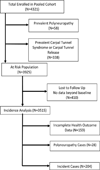Prevalence and incidence of carpal tunnel syndrome in US working populations: pooled analysis of six prospective studies
- PMID: 23423472
- PMCID: PMC4042862
- DOI: 10.5271/sjweh.3351
Prevalence and incidence of carpal tunnel syndrome in US working populations: pooled analysis of six prospective studies
Abstract
Objectives: Most studies of carpal tunnel syndrome (CTS) incidence and prevalence among workers have been limited by small sample sizes or restricted to a small subset of jobs. We established a common CTS case definition and then pooled CTS prevalence and incidence data across six prospective studies of musculoskeletal outcomes to measure CTS frequency and allow better studies of etiology.
Methods: Six research groups collected prospective data at > 50 workplaces including symptoms characteristic of CTS and electrodiagnostic studies (EDS) of the median and ulnar nerves across the dominant wrist. While study designs and the timing of data collection varied across groups, we were able to create a common CTS case definition incorporating both symptoms and EDS results from data that were collected in all studies.
Results: At the time of enrollment, 7.8% of 4321 subjects met our case definition and were considered prevalent cases of CTS. During 8833 person-years of follow-up, an additional 204 subjects met the CTS case definition for an overall incidence rate of 2.3 CTS cases per 100 person-years.
Conclusions: Both prevalent and incident CTS were common in data pooled across multiple studies and sites. The large number of incident cases in this prospective study provides adequate power for future exposure-response analyses to identify work- and non-work-related risk factors for CTS. The prospective nature allows determination of the temporal relations necessary for causal inference.
Figures
Comment in
-
What is the true prevalence of carpal tunnel syndrome among US workers?Scand J Work Environ Health. 2014 Jan;40(1):100. doi: 10.5271/sjweh.3391. Epub 2013 Oct 11. Scand J Work Environ Health. 2014. PMID: 24121819 No abstract available.
-
The prevalence and incidence of carpal tunnel syndrome in US working populations.Scand J Work Environ Health. 2014 Jan;40(1):101-2. doi: 10.5271/sjweh.3404. Epub 2013 Nov 19. Scand J Work Environ Health. 2014. PMID: 24252999 No abstract available.
References
-
- Stapleton MJ. Occupation and carpal tunnel syndrome. Anz Journal of Surgery. 2006 Jun;76(6):494–496. http://dx.doi.org/10.1111/j.1445-2197.2006.03770.x. - DOI - PubMed
-
- US Bureau of Labor and Statistics, US Department of Labor, 2011. Nonfatal occupational injuries and illnesses requiring days away from work, 2010. [Retrieved October 3, 2012];USDL report number: 11-1612. from: http://www.bls.gov/news.release/osh2.nr0.htm.
-
- Foley M, Silverstein B, Polissar N. The economic burden of carpal tunnel syndrome: long-term earnings of CTS claimants in Washington State. Am J Ind Med. 2007 Mar;50(3):155–172. http://dx.doi.org/10.1002/ajim.20430. - DOI - PubMed
-
- Faucett J, Blanc P, Yelin E. The impact of carpal tunnel syndrome on work status: Implications of job characteristics for staying on the job. J Occup Rehab. 2000;10(1):55–69. http://dx.doi.org/10.1023/A:1009441828933. - DOI
-
- Roquelaure Y, Mariel J, Dano C, Fanello S, Penneau-Fontbonne D. Prevalence, incidence and risk factors of carpal tunnel syndrome in a large footwear factory. Int J Occup Med Environ Health. 2001;14(4):357–367. - PubMed
Publication types
MeSH terms
Grants and funding
LinkOut - more resources
Full Text Sources
Other Literature Sources
Medical
Research Materials
Miscellaneous



